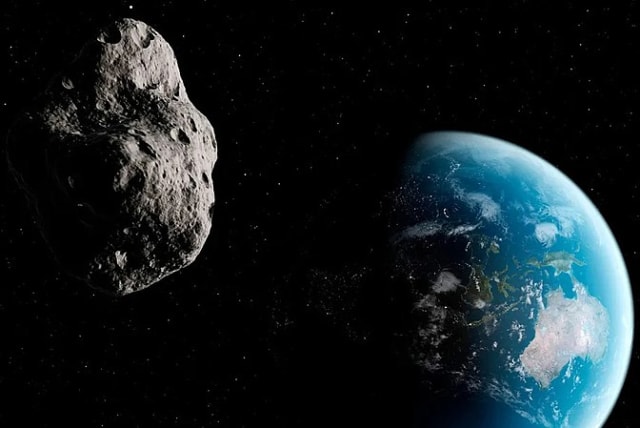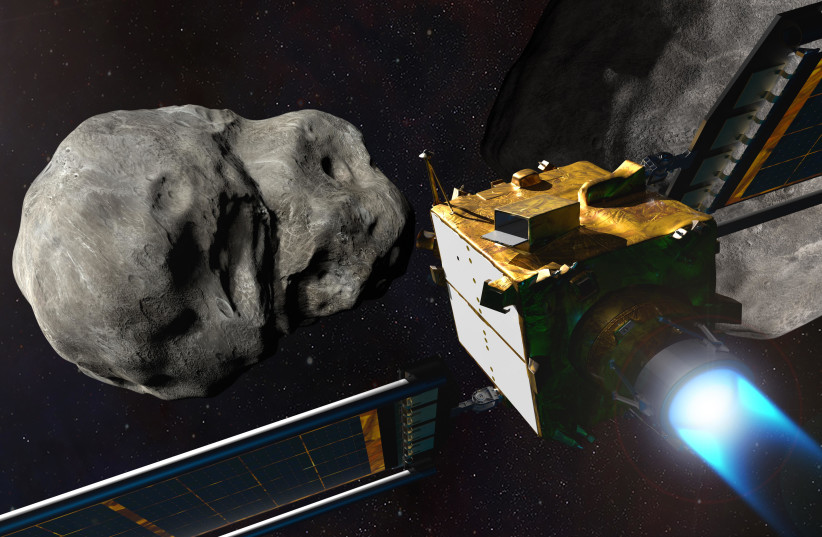Asteroid the size of 145 horses to pass Earth on Purim - NASA

Asteroid 535844 (2015 BY310) is estimated to be as much as 250 meters in diameter, around as much as 145 Clydesdale horses, and it's passing us on Purim.
A massive asteroid the size of 145 Clydesdale horses is heading toward Earth on Tuesday, according to NASA's asteroid tracker.
The asteroid in question has been designated 535844 (2015 BY310), having been discovered back in 2015, according to the Center for Near-Earth Object Studies (CNEOS) at NASA's Jet Propulsion Laboratory (JPL).
This asteroid's arrival comes as most of the Jewish world celebrates Purim, a Jewish holiday that – technically – involved horses at one specific point in the story.
How big is the asteroid coming toward Earth in 2023?
Asteroid 535844 (2015 BY310) is by no means small. According to NASA's estimates, its diameter is possibly as large as 250 meters.
To put such an astronomical size into more terrestrial metrics, the average male Clydesdale horse – the one made famous by Budweiser – can grow to around 172 centimeters in height. That means that at maximum, asteroid 535844 (2015 BY310) can be a bit over 145 fully grown male Clydesdale horses stacked on top of each other.
The average fully-grown male Clydesdale horse also weighs around 850 kilograms, so 145 of them would be around 123,250 kilograms in total.
And yes, the odds are that this asteroid is considerably heavier. But who's to say for sure? After all, there's always a chance that this asteroid is a rubble pile, therefore its mass may not be so clear cut.
The average Clydesdale can also run at around 32 kilometers per hour. And suffice it to say, it would be the wrong horse to back in a race between it and asteroid 535844 (2015 BY310), which is clocking in at around 7.72 kilometers per second, or 27,792 kilometers per hour.
Now, there is no clear consensus on the horse in the Purim story – upon which Mordechai rode in a triumphant celebration, led by a humiliated Haman, as described in the events of the Book of Esther – but it was almost certainly not a Clydsdale. However, it seems certain that whatever horse it was would still be far slower than this asteroid.
Is an asteroid going to hit Earth in 2023?
Asteroid 535844 (2015 BY310) is an Apollo-class asteroid, meaning its orbit around the Sun overlaps with Earth's own orbit. These types of asteroids are seen by some as some of the riskiest when it comes to potential impact scenarios.
Now, you might be worried about a massive asteroid hitting the Earth this Purim, perhaps being God's way of making noise when Haman's name is mentioned during megillah reading, or maybe as a strange cosmic form of mishloah manot where the gift is a catastrophic impact that lays waste to entire cities.
But rest assured, that won't happen this Purim.
While asteroid 535844 (2015 BY310) will be passing us by, it will do so at a distance of over 4 million kilometers away. On a cosmic scale, that's still somewhat close, but it's nowhere near as close as the Moon, which orbits at around 384,000 kilometers away from the Earth on average.
And we should be thankful for that too, because if this asteroid did actually hit the Earth, it would certainly be big enough to do some major damage, with the Davidson Institute of Science, the educational arm of Israel's Weizmann Institute of Science, saying that an asteroid 140 meters in diameter or more would release an amount of energy at least a thousand times greater than that released by the first atomic bomb.
But while this doesn't seem likely to happen, smaller asteroid impacts have and will continue to occur on Earth.
Here are some examples.
Back in March 2022, a small asteroid around half the size of a giraffe known as 2022 EB5 hit the Earth just hours after its discovery. But given how small it was, it didn't result in any damage.
More recently, in late November 2022, tiny asteroid 2022 WJ1 harmlessly exploded into fragments that scattered around Lake Ontario. NASA had predicted that this small meter-long asteroid would impact this location and knew there wouldn't be any harm from it.
On February 13, 2023, asteroid 2023 CX1, twice the size of a Super Bowl trophy, impacted Earth near Normandy, France. This, too, caused no damage.
And most recently, just a few days after that, a meteor around the size of a Pembroke Welsh Corgi and the total weight of four baby elephants struck the Earth in Texas.
Interestingly, another even larger asteroid is set to pass by the Earth on Wednesday, the holiday of Shushan Purim, where Purim is observed in certain cities like Jerusalem – and this asteroid will come a bit closer and a lot faster than its predecessor.
Do we have any way to stop an asteroid from hitting the Earth?
Scientists working in planetary defense are hard at work trying to devise ways of keeping the Earth safe from asteroids. Most notable among these is NASA's Double Asteroid Redirection Test (DART) Mission, which was launched to crash into the faraway asteroid Dimorphous in the Didymous system in order to see if its trajectory would be altered.
To put it simply, they punched an asteroid with a spacecraft to make it move, changing its orbital trajectory. And it worked.
A recent study has also reaffirmed its success, with scientists now certain they could adequately prevent an impact from a dangerous asteroid, provided we have a few years' notice.
And with scientists finding more ways to spot our many rocky neighbors in space – including an initiative to spot asteroids coming from the direction of the Sun, which are harder to spot due to the Sun's glare – this seems like a certainty.
Jerusalem Post Store
`; document.getElementById("linkPremium").innerHTML = cont; var divWithLink = document.getElementById("premium-link"); if (divWithLink !== null && divWithLink !== 'undefined') { divWithLink.style.border = "solid 1px #cb0f3e"; divWithLink.style.textAlign = "center"; divWithLink.style.marginBottom = "15px"; divWithLink.style.marginTop = "15px"; divWithLink.style.width = "100%"; divWithLink.style.backgroundColor = "#122952"; divWithLink.style.color = "#ffffff"; divWithLink.style.lineHeight = "1.5"; } } (function (v, i) { });


